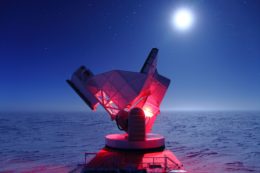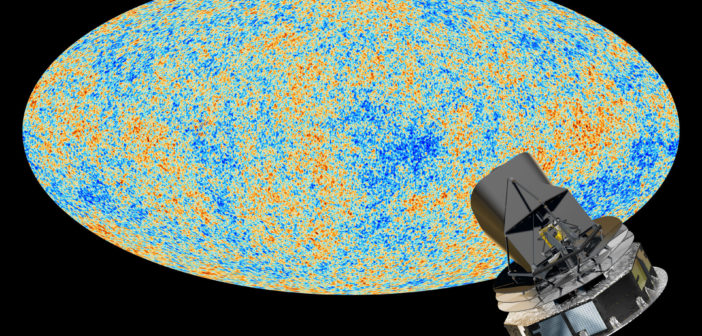The cosmic microwave background is leftover radiation from the Big Bang. It holds an enormous amount of information, and despite being from the beginning of the universe, it could tell us how the universe is going to evolve in the future.

The South Pole Telescope, which is also part of the Event Horizon Telescope network. [Daniel Luong-Van/National Science Foundation]
Polarizing Measurements
One of the informative properties of cosmic microwave background (CMB) radiation is its polarization. In this case, polarization refers to how the component waves of the radiation are oriented relative to the direction the radiation is traveling in. Cosmological models are especially sensitive to the E-mode and B-mode polarizations of the CMB, where the E-mode is the component that is oriented parallel or perpendicular to the direction of travel while the B-mode is oriented at 45 degrees to the travel direction.
The E-mode of the CMB is especially interesting because it provides a measurement of the Hubble constant, a parameter that describes how quickly the universe is expanding. The Hubble constant can be measured in a variety of ways, and every technique ought to yield a similar value. However, this hasn’t turned out to be the case! The discrepancy between different measurements of the Hubble constant is an active area of research, and the E-mode-based value of the Hubble constant could help us understand the significance of this discrepancy.
We currently have three E-mode datasets to work with: one from the Planck satellite, one from the Atacama Cosmology Telescope ACTPol Receiver, and one from the South Pole Telescope SPTpol camera. We can derive individual measurements of the Hubble constant from each of these datasets, but what if we combined them? A study by Graeme Addison (Johns Hopkins University) does exactly that.
Modes and Models
Temperature fluctuations in the CMB and the overall distribution of normal matter (as opposed to dark matter) in the universe put the Hubble constant at about 67 kilometers per second per megaparsec. However, galaxy distances derived from variable stars and supernovae suggest the Hubble constant has a value of 73. These measurements are precise enough that there’s no overlap between their uncertainties.
The E-mode measurements of the Hubble constant made using each of the available datasets range from 70 to 73, though the uncertainty is larger than it is for the highest precision measurements. However, when all three datasets are combined, the value of the Hubble constant ends up being about 69, with a small enough uncertainty that the measurement is distinct from those made using galaxy distances. How could this happen?

The Hubble constant plotted against various model parameters with different confidence intervals. The darker regions have a higher confidence than the lighter regions. The rightmost plot shows the range of values for the Hubble constant predicted for each dataset and the combination of all three datasets, with the distribution peaking at the likeliest value. The rightmost plot also contains two distributions for the ACTPol dataset, which have different assumptions. Click to enlarge. [Adapted from Addison 2021]
The bottom line is that the E-mode of the CMB seems to be in agreement with the CMB’s temperature fluctuations, which favors the current dominant model of the universe. The initial higher values of the Hubble constant could be caused by the inherent uncertainty in making observations of the CMB (it’s really hard!). At any rate, the discrepancy between different measurements of the Hubble constant continues to be a fascinating problem.
Citation
“High H0 Values from CMB E-mode Data: A Clue for Resolving the Hubble Tension?” Graeme E. Addison 2021 ApJL 912 L1. doi:10.3847/2041-8213/abf56e

